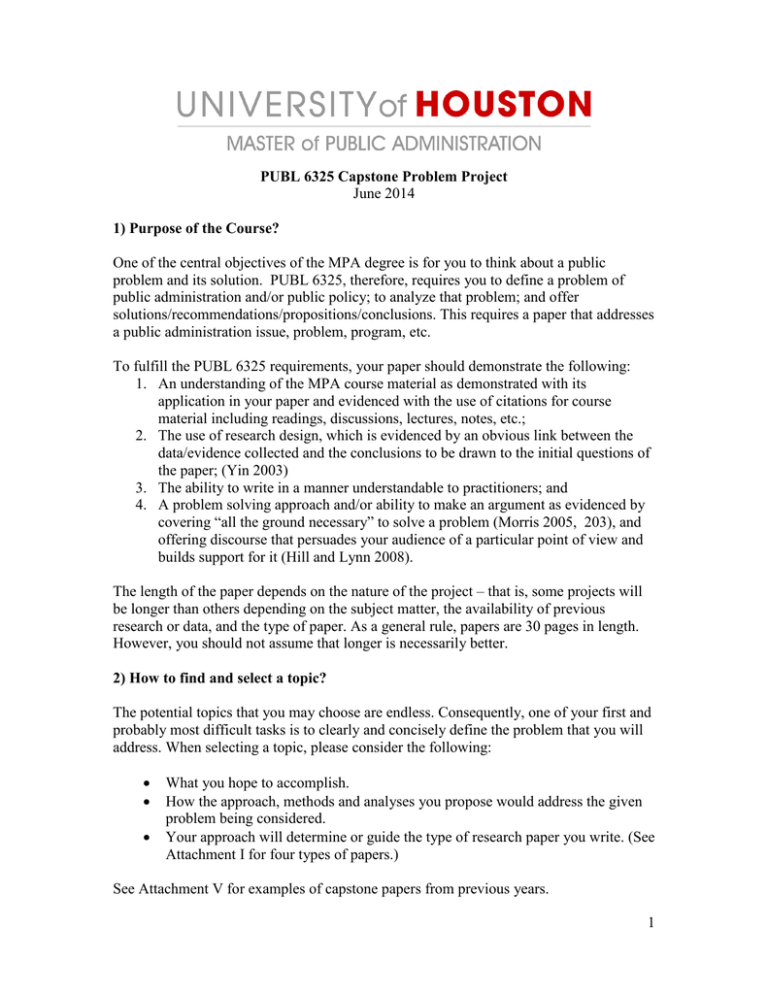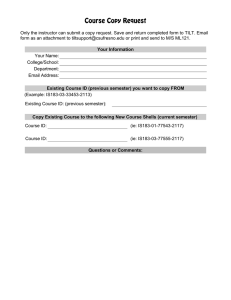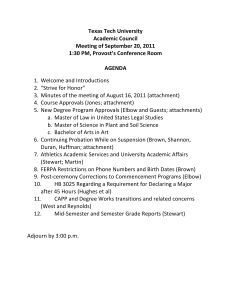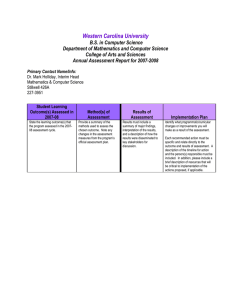June 2014
advertisement

PUBL 6325 Capstone Problem Project June 2014 1) Purpose of the Course? One of the central objectives of the MPA degree is for you to think about a public problem and its solution. PUBL 6325, therefore, requires you to define a problem of public administration and/or public policy; to analyze that problem; and offer solutions/recommendations/propositions/conclusions. This requires a paper that addresses a public administration issue, problem, program, etc. To fulfill the PUBL 6325 requirements, your paper should demonstrate the following: 1. An understanding of the MPA course material as demonstrated with its application in your paper and evidenced with the use of citations for course material including readings, discussions, lectures, notes, etc.; 2. The use of research design, which is evidenced by an obvious link between the data/evidence collected and the conclusions to be drawn to the initial questions of the paper; (Yin 2003) 3. The ability to write in a manner understandable to practitioners; and 4. A problem solving approach and/or ability to make an argument as evidenced by covering “all the ground necessary” to solve a problem (Morris 2005, 203), and offering discourse that persuades your audience of a particular point of view and builds support for it (Hill and Lynn 2008). The length of the paper depends on the nature of the project – that is, some projects will be longer than others depending on the subject matter, the availability of previous research or data, and the type of paper. As a general rule, papers are 30 pages in length. However, you should not assume that longer is necessarily better. 2) How to find and select a topic? The potential topics that you may choose are endless. Consequently, one of your first and probably most difficult tasks is to clearly and concisely define the problem that you will address. When selecting a topic, please consider the following: • • • What you hope to accomplish. How the approach, methods and analyses you propose would address the given problem being considered. Your approach will determine or guide the type of research paper you write. (See Attachment I for four types of papers.) See Attachment V for examples of capstone papers from previous years. 1 Chose a topic that is “manageable” in one semester – i.e., you can actually accomplish it and generate a quality paper. Make it large enough to require some serious work and small enough to be done by you alone. 3) When should I take PUBL 6325? Generally, the capstone project is the final task to be completed prior to graduating with an MPA Degree. You should usually enroll in the course during your last semester (i.e., in the semester that you intend to graduate). It is best to informally start the project prior to that time. Indeed, you should begin as soon as possible defining your project, and submit your proposal the semester prior to your enrollment in 6325. Ideas for your project may arise from your readings, course discussions, work experience, and current salient topics. Summer enrollment is limited to three students at the most and depending on faculty availability so make allowances for this when planning your degree schedule. Do not assume that you can take PUBL 6325 in the summer. Please note that if your capstone paper is not acceptable for whatever reason, you will receive a non-passing grade. If by some chance, your paper has potential, then you may be given an incomplete “I” and will have one year to finish the paper. You must be enrolled the semester that you complete an “I”. 4) When is the final paper due? Submit the final paper, not a draft, three to four weeks prior to the final exam week in the semester you wish to graduate. Your approved prospectus should indicate the specific date. 5) Can I develop a project out of my work experiences? The answer is a qualified yes. The capstone project is your individual accomplishment. If the problem that you deal with arises from your work experience, it should be approved by your superior. This includes the superior defining the problem and assigning it to you. 6) Collaborative Efforts Collaborative efforts on Capstone Projects are allowed, but more is expected from a group effort than an individual effort. The purpose of a collaborative effort in our academic environment is not meant to create less work for you but to generate a better product – i.e., a more in-depth and researched paper. If you are contemplating a collaborative effort, visit with the MPA Program Director prior to beginning your prospectus. 2 7) What is the process of completing the final paper? The final paper is usually completed in three steps: 1) The prospectus, your initial proposal, which provides a research design – i.e., a plan of action to direct you to the final objective. (See Attachment IV for a brief discussion of research design.) Ideally, this research design would be submitted before the start of the semester in which will be enrolled for PUBL 6325. This means December for the spring semester, May for the summer semester, and August for the fall semester. This ensures that you are ready to work on your project from day one of the semester. The prospectus must be approved by your capstone advisor before you start work. Once a prospectus is approved, you cannot change it without your advisor’s approval. 2) A polished draft that is reviewed by your advisor for needed revisions, etc. 3) The final paper after any revisions resulting from step 2. All the steps are mandatory. They are interrelated and will determine your final grade. The prospectus is a critical step in the process. You should view the prospectus as a road map directing you through the terrain of your project. How well that road map details your project will allow you to avoid roadblocks, detours, and breakdowns along the way (See Attachments II and IV for information on research design.). As in most cases, the quality of your prospectus will determine the quality of your final product. 8) What should I include in my prospectus? At a minimum, the prospectus should be organized around the following: 1) Statement of the Problem: a) Why is the problem important as an issue of public administration and/or public policy? The importance may be stated theoretically or substantively. That is to say, you may work from an abstract frame of reference to establish the parameters of your problem, or you may work from a concrete example as illustrated above. b) Based on a) above, what do I assume I will find? Here, you will state those assumptions as conclusions (hypotheses, propositions etc.), although you have not substantiated them. These conclusions will guide you to the final objective. 2) Methods/Approach: a) What type of paper am I proposing? (See Attachment I for four examples.) Will it adequately and professionally address my problem, question, issue, etc.? b) What research method should I use? (See Attachment IV for basic information on research design.) What kind of data do I need and what method should I use to look into the problem or question being addressed in my paper? Be sure and apply the tools you learned in quantitative 3 methods to your research. (See Attachment III for a list of research methods.) c) What data do I need to analyze the problem? Here you must have a logical reason for selecting the data. This is why the research design is important. d) How will I analyze the data? (See Attachment III for a list of statistical techniques depending upon the question and the research method.) The scheme of analysis should include more than methods, albeit it is important that you know what the best methods to analyze your data are available. You should also indicate how you will organize the information that you collect (e.g. categories or typologies). 3) Topical Outline: You need to provide a topical outline of your project that addresses what your final paper will include. 4) Bibliography You need to append a working bibliography (An annotation of 2.a) above). James Thurmond, Ph.D. Director, Master of Public Administration jhthurmond@uh.edu 713-743-3930 4 Attachment I Types of Papers for PUBL 6325 Please note that these papers are not necessarily mutually exclusive. That is, some element of each might be used in another. For example, it would not be unusual for a position paper to include analytical results from a cost-benefit analysis or statistical analysis. 1. Policy Analysis: Use if you are problem-solving and seeking the best way to solve a public problem. With a policy analysis paper, you should adhere to standard procedures including: a. Compare a number of alternative approaches and determine which offers the best solution to the problem. b. Establish criteria for selecting the best alternative. c. Be able to measure various outcome of each alternative in order to justify and defend your decision. 2. Program Evaluation: Use if you are determining the efficiency and/or effectiveness of a particular public program, public good, or public service. With a program evaluation, you should follow good evaluation procedures including: a. Document and assess the activities, outputs, outcomes, and costs of the program, good, or service. b. Determine whether the program can be improved; should it be improved; should be remain as is; should it be eliminated; etc.? 3. Administrative Analysis: Use if you are assessing an administrative program to determine its fate. Look at the administrative program from various perspectives (e.g., departmental, employees, community, organizational structure, ecological, etc.). Take a case study approach to fully understand and explain the administrative program. 4. Position Paper: Use if you are developing a policy argument to support a claim that something should or should not be done. Position papers have two main components: a claim and its support. The claim asserts what should or should not be done. Support for the claim presents the facts, interpretations, and assumptions that lead to making that claim. Your goal is to convince others to accept the claim and to agree with the position. (Smith, Catherine F., Writing Public Policy, 2010) 5 Attachment II Research Design A research design is a plan for carrying out your capstone project. It lays out the problem to be examined, the program to be evaluated, the policy to be analyzed, and the propositions, recommendations or conclusions to be presented. Then it puts them in the context of the research that has already been done or the information already available, and explains how the necessary information will be gathered and applied to support or test the propositions, recommendations or conclusions. In a research design, you are providing a plan of how to do the work in the allotted time. You will need to research existing studies, writings, and current events on the topic. You will also have to figure out how to obtain the necessary data, what methods you will use in applying it, and the standards you will use to evaluate your program, policy, propositions, recommendations, or conclusions. See Attachment V for the eight steps of the research design process (Berner, Maureen, 2012, Practical Uses for Better Decision Making, ICMA Press.) 6 Attachment III Types of Research Techniques/Methods Depending on Research Purpose and Question (Shields, Patricia M., A Pragmatic Teaching Philosophy, JPAE, 2003) 7 Attachment IV – The Research Design Process (Berner, Maureen, 2012, Practical Uses for Better Decision Making, ICMA Press.) 8 Attachment V - Examples of Capstone Topics MPA Program Capstone Projects Spring, 2012 Name of Project ANALYSIS OF ADVANTAGES AND DISADVANTAGES OF THE TRADE PROMOTION AGREEMENT COLOMBIA -UNITED STATES IN THE COLOMBIAN AUTOMOBILE SECTOR Improving Agency Coordination in the Fight Against Human Trafficking A Guide for Public Administrators Seeking to Enhance Coordination among Law Enforcement and Social Service Agencies Gambling on the Future: Assessing the future feasibility of implementing Casino-style gambling in Texas Deer Park LEPC Pipeline Rupture Exercise AN EVALUATION OF MUNICIPAL LOBBYING EFFORTS IN TEXAS: COLLABORATIVE PUBLIC MANAGEMENT IN ACTION THE NEED TO DIVERSIFY THE ECONOMIC TAX BASE FOR THE CITY OF MONT BELVIEU: A STRATEGY United States Deep Water and Coastal Water Oil Spill Response Policy: An Evaluation of Pre-Policy and Post-Policy Cleanup Response and a Path Beyond Deepwater Horizon MPA Inaugural Luncheon Event Summary and Evaluation Barriers of Health Care Reform in Rural Areas: Evidence from In-Depth Interviews A Case Study of Tax Increment Reinvestment Zones in Houston: Evaluating the Impact of Fiscal Policy and Social Equity Uninsured Young Adults in Texas: A Policy Analysis Policy Alternatives for Reducing the Aggregated State Burden of Uncompensated Care Alternatives to Houston’s Red Light Camera Program: A Policy and Cost-Benefit Analysis 9


